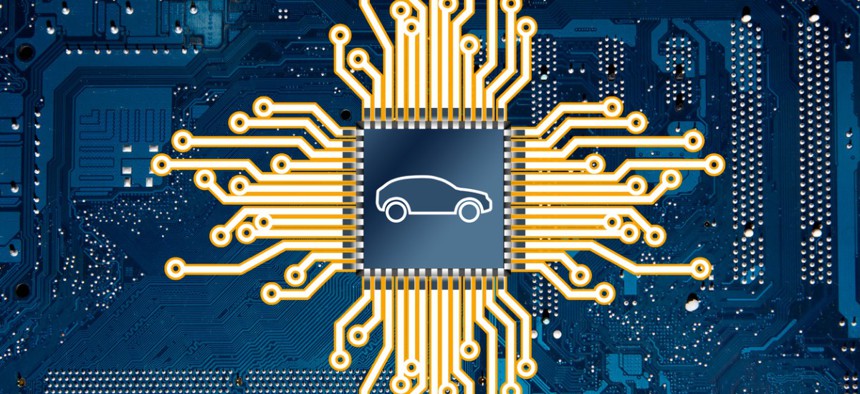Chip Shortage Threatens Modernization—and Everything Else

Jae Young Ju/iStock.com
Initially, the chip shortage mostly affected car manufacturers.
If you can read this, thank your chips.
Full disclosure: You should probably also take the advice of the classic slogan and thank a teacher for showing you how to read. But since this is an online column, you couldn’t enjoy it without first loading it up on your tablet, smartphone or computer, devices that depend on computer chips to give them their functionality. And that does not even take into account all of the servers, devices and communications hardware that makes up the internet links between your screen and the Nextgov website. Without computer chips in any of those areas, you would just be looking at a blank screen.
And that is troubling because of a global chip shortage brought about mostly by the pandemic, but also because many of the global computer chip factories are concentrated in just one part of the world. Most are in Asia, which was hit especially hard by the COVID-19 virus.
Initially, the chip shortage mostly affected car manufacturers. It’s hard to believe, but every modern vehicle has between 50 and 300 computer chips embedded inside them. They control everything from performance to fuel efficiency and, of course, drive advanced functions like satellite navigation. Some high-end vehicles can have thousands of chips. In fact, computer chips and electronics make up about 40% of the cost of a new car these days. Given that, it’s no wonder that news of car manufacturers shutting down due to a lack of available chips is becoming more prevalent. Just last week, Hyundai had to temporarily close a major plant in Alabama because it couldn’t get enough chips for its new cars.
I have personally been affected by the shortage, though in an admittedly minor way. It took me months of trying to finally get a hold of a PlayStation 5 game console. Having a lot of people stuck at home wanting to play games to alleviate quarantine boredom increased the demand for the console. And the global chip shortage reduced the available supply. All of that made finding a new console to buy about as difficult as getting front row concert tickets.
Based on my own adventure acquiring a PlayStation, the chip shortage was somewhat in the front of my mind, but I didn’t expect it to also start slowing down government modernization efforts. But it’s apparently having an impact there too.
I was attending a virtual conference on government modernization the other week that included talks from government contractors as well as some federal and state officials. I was surprised to hear that while they were able to ramp up with new capabilities quickly to support a massive spike in telework at the start of the pandemic, some ongoing efforts were now stalled because of a lack of necessary infrastructure hardware. You can blame the chip shortage for that as well.
Government Response
With chip factories slowly getting back into production, this chip shortage should be temporary. But it does put a spotlight on a potential problem that could have been much worse, and which might very well be worse in the next crisis.
As chip shortage problems were just getting started, President Joe Biden issued Executive Order 14017, which formed a committee to investigate difficulties with the national supply chain. They looked at medicine and other important resources, but computer chip manufacturing was also studied by the committee. Their final report on the issue was just released.
Among other things, the report recommends that the Department of Commerce provide nearly $75 billion in direct investments for domestic semiconductor manufacturing, something the administration is actively supporting. It also calls for government to continue to help chip manufacturers based in Japan and South Korea so they can increase their production numbers and overall capacity.
Looking at the raw materials part of chip and electronics production, the report also stresses the need to bring the mining and processing of rare earth materials into the United States. To that end, the Department of Interior, with the support of the White House Office of Science and Technology Policy, will establish a working group composed of the Department of Agriculture and the Environmental Protection Agency to identify sites where critical minerals could be produced and processed domestically. This will help not only with chip manufacturing but also building the lithium batteries that drive many of our electronic devices.
The goal of all of these efforts is twofold. First, it will bring critical assets and manufacturing within the borders of the United States where they can be protected and better controlled. And secondly, it will disperse factories and processing centers so that local or regional problems don’t completely disrupt global operations.
Although many of these efforts will take years to come to fruition, I’m glad that they are getting started. Hopefully, government modernization programs will get back on track, and we will be better prepared for the next big crisis. And who knows, it might make it easier for me to buy a PlayStation 6 whenever those are eventually created.
John Breeden II is an award-winning journalist and reviewer with over 20 years of experience covering technology. He is the CEO of the Tech Writers Bureau, a group that creates technological thought leadership content for organizations of all sizes. Twitter: @LabGuys






